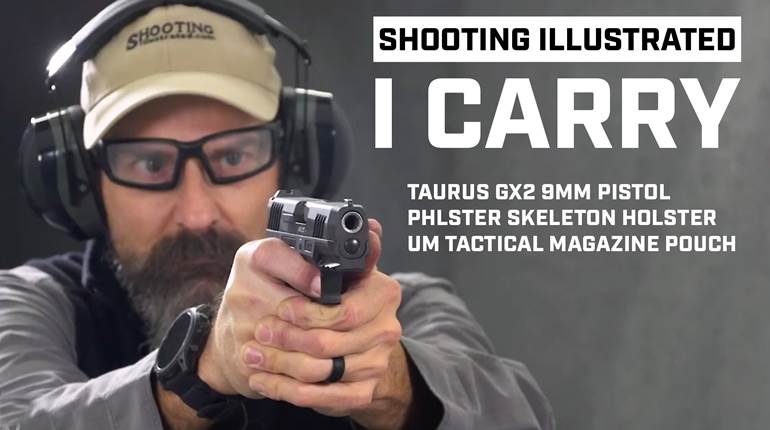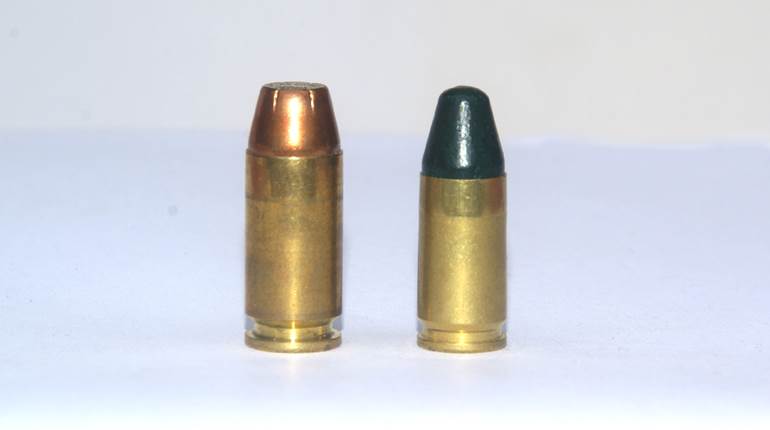
The last few years have been particularly kind to Beretta 92 fans. Beretta launched the M9A3 and 92X platforms. Wilson Combat and Langdon Tactical Technology each collaborated for well-received special-edition pistols that thrilled fans and introduced the platform to many new shooters.
However, 92 fans collectively took a look at the rear of their slides with the vertically protruding firing-pin blocks, various pins along with limited space and felt largely excluded from the current trend of mounting red-dot optics to pistols. You could almost hear the forlorn sighs coming from the Beretta 92 crowd every time a new optic or mounting solution was introduced. Langdon Tactical just fixed that with the release of its Elite LTT RDO (Red-Dot Optic) and custom slide work options.
The Langdon Tactical Mounting Solution
Langdon Tactical looked at the back end of the Beretta 92 and realized that in order for a red-dot solution to meet its potential, the firing pin and firing-pin block would have to be redesigned. Langdon redesigned the parts to where the firing pin block is held in place by the firing pin in a fashion similar to that found on Beretta’s PX4 series of pistols.
This allows LTT to mill the slide as deeply as possible, limited only by the placement of the extractor notch. Langdon removes the rear sight dovetail to allow optics to be mounted as far to the rear as possible, especially important with those like the Trijicon SRO that ‘overhang’ slightly forward of the mounting footprint.
As impressive an engineering feat as retrofitting a different firing pin and block is, there may be some understandable concern about altering a safety mechanism on a well-proven pistol design. Langdon addressed this head-on by conducting standardized drop testing with the video available online.

The mount itself is a well-designed piece of work. Quite frankly, many mounting solutions on the market are relatively crude, often emphasizing efficiency for the manufacturer and simply creating an inlet and tapped-screw holes to bolt an optic down. The LTT unit is closely fit to the standard RMR footprint, having the matching forward radius and raised screw towers to provide further support to the optic.
The mounting plate is secured to the slide with a dovetail and three screws rather than the two commonly seen in other mounts. A bonus that is invisible to the shooter is that the slide-to-mount interface has a recoil boss machined into the underside to further support the mount. This may be the most robustly affixed mount currently on the market.
I mounted a Trijicon SRO and found it to be a very close fit and quite well supported. Early in testing, I fired the pistol with only one mounting screw in place through the optic and was still able to get hits to 50 yds. and beyond. With thread-locker in place on two screws, I have seen no movement in the witness marked screws and no zero-shift in more than 1,600 rounds.
Since the mounting pocket removes the rear sight dovetail, the LTT plate incorporates a fixed rear sight paired with a suppressor height white-dot front sight. The irons were just visible in the bottom fifth of the SRO's window.
The irons provide a nice sight picture on their own and were quite usable in their own right, being well regulated and allowing me to hit an 8” plate out to 40 yds. The front sight is just tall enough that holster fit may be affected. I used a JM Custom Kydex belt and AIWB holsters that were specifically made to accommodate both the optic and the sight heights.

To make the RDO happen, Langdon had to modify or redesign the de-cocking lever, the safety plunger and the extractor pin in addition to the previously mentioned firing pin and block. The overall effect in the patent pending RDO is a dot only 0.85” over the bore, one of the lowest mounting solutions on the market. For comparison, a custom match 1911 that I shoot particularly well measured 0.79” to the top of the rear sight blade.
The RDO is just a fraction over common iron target sights. I’ve shot with Ernest Langdon, a friend for 20 years, and I have never seen him as enthusiastic as he is over this project. I think it is equal parts the technical difficulty of what LTT pulled off and how the RDO actually performs in hand.
Shooting the Elite LTT RDO
My personal bests across a wide variety of challenging shooting drills, standards and challenges are split between the 1911 and the Beretta Elite LTT. The customized Beretta 92 is a fantastic shooting platform and LTT’s custom action work and optimized parts simply add even more to the plus side of the ledger. I was curious to see just how different the Elite LTT was with the Trijicon SRO mounted.
The very first thing I noticed, and was reinforced every time I showed the pistol to local shooters, was just how naturally the dot sat in relation to the pistol. Many platforms have the dot sitting a plane or three above where the shooter ‘expects’ it to be naturally.
This requires effort and training for the dot to naturally present to the shooter’s eye as the pistol is extended on target. The LTT RDO had the most natural dot presentation of any pistol I’ve yet handled. Some of this is undoubtedly the larger and circular SRO lens, but the dot itself is in a very favorable location for the shooter.
I was curious if the deep mounting depth would have side effects. Even with the nearness of the optic to the breech face and the slight overhang of the Trijicon SRO design, ejection was consistent which typically puts fired brass into neat clustered piles. There were no instances of ejecting brass ricocheting off of the optic and very little powder residue even after 300-round training sessions.
The Elite LTT’s have a reputation for accuracy. The one I tested a few years ago averaged 1.82” at 25 yds. The RDO unit delivered as well. Hornady’s Subsonic line of 147-gr. XTPs knotted up very impressive groups averaging 1.61” for five groups. One of my go-to match loads consisting of a 147-gr. Zero brand JHP over 3.2 grs. of TiteGroup (a load that was coincidentally recommended to me by Ernest Langdon a few years back) averaged 1.70” across five groups.
That accuracy was evident in every challenge I threw at the RDO. I was calling shots at 25 yds. with an almost omniscient level of precision. At 7 yds., I fired a group into a paster target, figuring the Beretta would keep them inside the 1” square. I called the final shot a touch low and the resulting group was a perfect heart-shaped hole for four shots and the one low flier.

I’ve been shooting the Beretta 92 series for close to 30 years; as a service weapon in units known for high-volume shooting, in competition and as a training tool. I fully appreciate the capabilities and limitations of the design and felt like I had long ago mastered the approach to both the double- and single-action trigger pulls.
I was fully surprised and rather excited when dry-firing the LTT RDO that I could see minor things happening in both my double- and single-action breaks reflected in the movement of the Trijicon SRO’s 2.5 MOA dot. Movements that were hidden in the iron sights were plainly visible in the dot. Taking that feedback and reacting to ‘calm’ the dot allowed me to gain an even more precise and repeatable break in both trigger modes.
Shooting the RDO was, in many ways, everything good about a Beretta 92 taken to another level. In my hands, the signature sweet-spot of the RDO and SRO combination was medium- to high-difficulty shots at max speed.
As an example, many shooters are familiar with ‘The Test’: 10 rounds at 10-yds. in 10 seconds into a standard B8 bullseye target. With the Elite LTT and its normal iron sights I am usually good for 99 to 100 points from the ready in about nine seconds. With the RDO, I attempted the drill while drawing from concealment (using a JM Custom Kydex AIWB holster) and my first attempt yielded a time of 7.9 seconds, with most of in the ‘X’ ring.
I had similar results at 25 yds., firing some particularly difficult timed drills into the head of a Wilson Combat scoreable steel silhouette. I had narrowly missed my goal of five hits within five seconds with the iron-sighted pistol, typically being over on time with five hits or under the limit with only four hits. Within only a few attempts with the RDO, I had a personal best across all platforms with a tightly centered cluster of hits well under the time limit.
The generous window of the Trijicon SRO and the soft shooting qualities of the Beretta 92 pair rather well to assist in keeping track of the dot in rapid fire. Likewise, the dot pairs superbly with the excellent single-action trigger break in a tuned Beretta 92 such as the LTT. You can see exactly what you need to on the target, and the trigger lets you put the shot there easily.

When I test some optic-equipped pistols, I often see a slight increase in times on standard drills up close. On close and relatively easy shots, there is often enough feedback in irons to shoot at a better speed until the shooter is very familiar with the given pistol and optic combo. For some combos, the learning curve is higher than others.
The LTT RDO with SRO combo was the strongest out of the gate of any I’ve handled. I was equaling or bettering my expected times up close within a couple of range days and at this point, the RDO is holding all platform bests on a number of close drills.
I had originally planned to try the Langdon Beretta 92 with an Trijicon RMR or a Holosun 507C, but I found I was enjoying the SRO so much that I didn’t care to take it off. I did try the RDO upper on both an M9A3 and a late 1980’s 92F to check compatibility. Both ran perfectly with the optic-equipped slide and Elite barrel.

As of this writing, I have just under 1,800 rounds through the LTT RDO pistol. Most of that is from my stash of ‘good’ factory ammo and match handloads. There have been no failures of any kind, with only a light cleaning at 1,200 rounds and a drop or two of oil in all of the right spots every 300 to 400 rounds.
That I have already run that much of my own ammo through the pistol in the middle of a serious ammo drought is a strong indication of my overall regard for it. I think the LTT RDO is going to make it into some practical competition and will also see adoption among the double- and single-action subset of serious defensive or duty shooters.
LTT 92 Elite Options
LTT is offering shooters several options to get into the RDO. The turnkey approach is as a complete package. Elite LTT RDO pistols are available in the fullsize, Centurion and Compact sizes.
Shooters that already have a Beretta 92 with a Vertec-style slide (M9A1, M9A3, Vertec, 92X and Elite LTT) can send in their slide to Langdon Tactical to be converted to an RDO. A third option will eventually be a complete slide unit available from LTT to retrofit onto standard Beretta 92s.
For more information on the Langdon Tactical Technology RDO and custom work options, visit langdontactical.com.





































